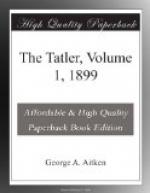[Footnote 87: Cibber writes thus of this actress: “Mrs. Mountford, whose second marriage gave her the name of Verbruggen, was mistress of more variety of humour than I ever knew in any one woman actress. This variety, too, was attended with an equal vivacity, which made her excellent in characters extremely different.... She was so fond of humour, in what low part soever to be found, that she would make no scruple of defacing her fair form to come heartily into it.” She could act admirably as a Devonshire lass, a pretty fellow, or a fine lady. Mrs. Verbruggen’s first husband, the actor Mountford, was killed by Captain Hill, with the assistance of Lord Mohun, in 1692, because Hill, who was making unsuccessful suit to Mrs. Bracegirdle was jealous of her fellow-actor. Mountford was then in his thirty-third year. Mrs. Mountford’s second husband, John Verbruggen, is described by Tony Aston as “nature without extravagance.” ... “That rough diamond shone more bright than all the artful polished brilliants that ever sparkled on our stage.” The same writer says of Mrs. Verbruggen: “She was all art, but dressed so nice, it looked like nature. She was the most easy actress in the world. Her maiden name was Percival.”]
[Footnote 88: Various Societies for the Reformation of Manners were founded in the reign of William III. An “Account” of these societies was published in 1699, and Defoe often wrote on the subject. In 1708 the Society for London and Westminster secured the conviction of 3299 “lewd and scandalous” persons, guilty of Sunday trading swearing, drunkenness, &c.]
[Footnote 89: See Steele’s apology to Blackmore, author of this poem, in No. 14. Sir Richard Blackmore (died 1729) was a Whig physician who wrote epics on religious and other subjects, and was often at loggerheads with the actors and wits. Though he was not a poet, Addison and Steele praised him on account of the religious tone of his work (see Spectator, Nos. 6, 339).]
[Footnote 90: Vanderbank, or as his father sometimes wrote his name, Vandrebanc, was a son of Peter Vanderbank, a Parisian, who came into England with Gascar the painter, about 1674, and died at Bradfield, in Hertfordshire, in 1697. His father was admired for the softness of his prints, and still more for the size of them, some of his heads being the largest that had then appeared in England; but the prices he received by no means compensated for the time employed on his works, and he was reduced to want, and died at the house of Mr. Forester, his brother-in-law. After his death, his widow sold his plates to one Brown, a print-seller, who made a great profit by them. His eldest son had some share in the theatre at Dublin; the youngest, William, was a poor labourer, who gave an account of his father and the family to Vertue. The person mentioned in this paper was probably his father’s name-son, and might be, as Walpole conjectures, an engraver. Whatever concern the father might have




